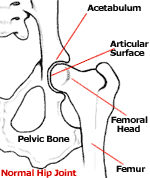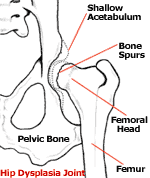Canine hip dysplasia is a very common degenerative joint disease seen in dogs. There are many misconceptions surrounding it. There are many things that we know about hip dysplasia in dogs, there are also many things we suspect about this common cause of limping, and there are some things that we just do not know about the disease. We will cover all of those here and hope to separate out fact, theory, hypothesis, and opinion.
What is hip dysplasia?
To understand what hip dysplasia really is we must have a basic understanding of the joint that is being affected. The hip joint forms the attachment of the hind leg to the body and is a ball and socket joint. The ball portion is the head of the femur while the socket (acetabulum) is located on the pelvis. In a normal joint the ball rotates freely within the socket. To facilitate movement the bones are shaped to perfectly match each other, with the
socket surrounding the ball. To strengthen the joint, the two bones are held together by a ligament. The ligament attaches the femoral head directly to the acetabulum. Also, the joint capsule, which is a very strong band of connective tissue, encircles the two bones adding further stability. The area where the bones actually touch each other is called the articular surface. It is perfectly smooth and cushioned with a layer of spongy cartilage. In the normal dog, all of these factors work together to cause the joint to function smoothly and with stability.
Hip dysplasia results from the abnormal development of the hip joint in the young dog. It may or may not be bilateral, affecting both right and left sides. It is brought about by the laxity of the muscles, connective tissue, and ligaments that should support the joint. Most dysplastic dogs are born with normal hips but due to genetic and possibly other factors, the soft tissues that surround the joint start to develop abnormally as the puppy grows. The most important part of these changes is
.
.
.






























